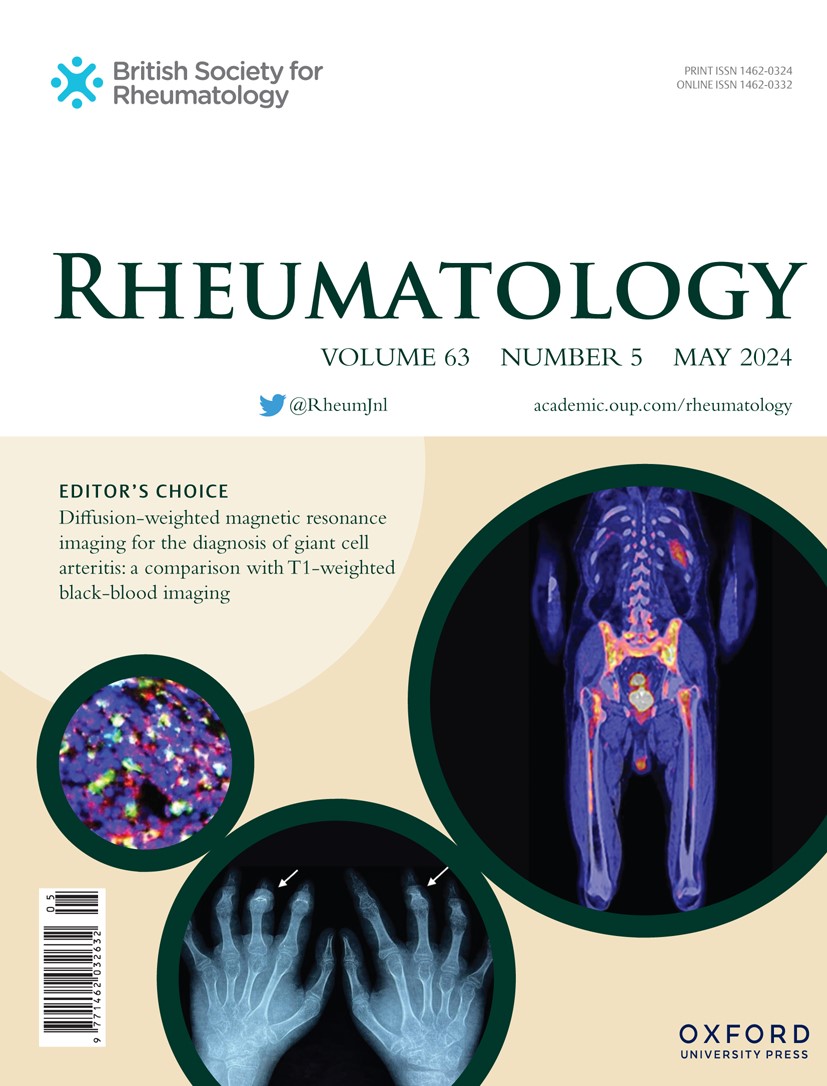Trends in remission rates for rheumatoid arthritis in England and Wales: a population-level cohort study
IF 4.7
2区 医学
Q1 RHEUMATOLOGY
引用次数: 0
Abstract
Objectives Considerable data support early treatment of rheumatoid arthritis (RA) to obtain disease remission. Data from the National Early Inflammatory Arthritis Audit (NEIAA) in England and Wales suggest that, despite recent improvements in referral-to-treatment times, remission rates remain unchanged. We investigated reasons for this disconnect by evaluating temporal trends, geographical variation, and predictors of remission in individuals with new RA diagnoses. Methods An observational cohort study of individuals with RA was conducted using data from NEIAA (May 2018 - April 2024). Temporal and geographical variation in remission rates (DAS28 < 2.6) were explored using interrupted time-series and case-mix-adjusted mixed-effects regression. Predictors of remission were assessed using multivariable logistic regression. Results 13 752 of 21 904 (62.8%) individuals with RA had data on DAS28 at 3 months after initial rheumatology assessment, of whom 4,764 (34.6%) achieved remission. National remission rates were stable from 2018 to 2024; however, wide geographical variation was observed, ranging from 28.4% (London) to 40.3% (East-of-England). Three-fold differences in remission rates were seen between individual hospitals within regions. Younger age, female sex, Black ethnicity, higher baseline DAS28, delayed DMARD initiation, and longer symptom duration were independently associated with reduced odds of remission. Delays between symptom-onset and referral have increased since the COVID-19 pandemic. Conclusion While national remission rates for early RA have remained stable in England and Wales since 2018, there is marked regional and hospital-level variation, highlighting ongoing inequities in service delivery. Addressing factors beyond referral-to-treatment time—particularly delayed presentation to primary care—is required to improve remission rates.英格兰和威尔士类风湿关节炎缓解率的趋势:一项人口水平的队列研究
目的大量数据支持类风湿关节炎(RA)的早期治疗以获得疾病缓解。来自英格兰和威尔士国家早期炎性关节炎审计(NEIAA)的数据表明,尽管最近转诊治疗时间有所改善,但缓解率保持不变。我们通过评估时间趋势、地理变化和新诊断的RA患者缓解的预测因素来调查这种脱节的原因。方法使用NEIAA(2018年5月- 2024年4月)的数据对RA患者进行观察性队列研究。缓解率的时间和地理差异(DAS28 <;使用中断时间序列和病例混合调整的混合效应回归对2.6)进行了探讨。使用多变量逻辑回归评估缓解的预测因子。结果21 904例(62.8%)RA患者中有13 752例(62.8%)在初始风湿病评估后3个月有DAS28数据,其中4,764例(34.6%)获得缓解。2018年至2024年,全国缓解率保持稳定;然而,观察到广泛的地理差异,从28.4%(伦敦)到40.3%(英格兰东部)不等。不同地区医院间缓解率的差异为3倍。年龄较小、女性、黑人、较高的基线DAS28、延迟的DMARD起始时间和较长的症状持续时间与缓解几率降低独立相关。自2019冠状病毒病大流行以来,出现症状和转诊之间的延误有所增加。自2018年以来,英格兰和威尔士早期类风湿性关节炎的全国缓解率保持稳定,但地区和医院层面存在明显差异,凸显了服务提供方面的持续不平等。要提高缓解率,需要解决转诊治疗时间以外的因素,特别是延迟到初级保健的时间。
本文章由计算机程序翻译,如有差异,请以英文原文为准。
求助全文
约1分钟内获得全文
求助全文
来源期刊

Rheumatology
医学-风湿病学
CiteScore
9.40
自引率
7.30%
发文量
1091
审稿时长
2 months
期刊介绍:
Rheumatology strives to support research and discovery by publishing the highest quality original scientific papers with a focus on basic, clinical and translational research. The journal’s subject areas cover a wide range of paediatric and adult rheumatological conditions from an international perspective. It is an official journal of the British Society for Rheumatology, published by Oxford University Press.
Rheumatology publishes original articles, reviews, editorials, guidelines, concise reports, meta-analyses, original case reports, clinical vignettes, letters and matters arising from published material. The journal takes pride in serving the global rheumatology community, with a focus on high societal impact in the form of podcasts, videos and extended social media presence, and utilizing metrics such as Altmetric. Keep up to date by following the journal on Twitter @RheumJnl.
 求助内容:
求助内容: 应助结果提醒方式:
应助结果提醒方式:


